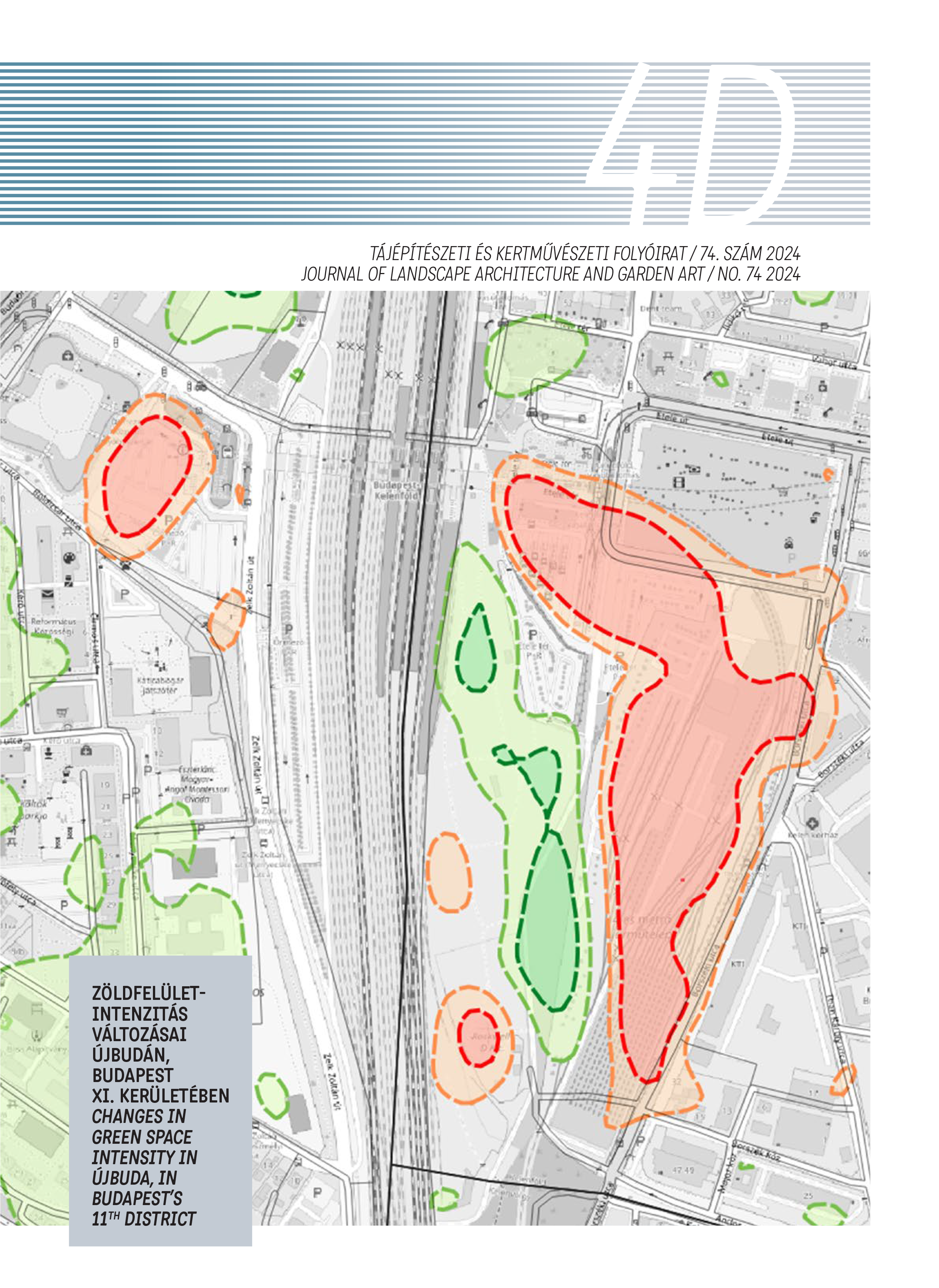A városkörnyéki zöldinfrastruktúra morfológiai szerkezete: Zhengzhou várostérség (Kína) példáján
DOI:
https://doi.org/10.36249/4d.74.5679Kulcsszavak:
városkörnyéki zöldinfrastruktúra, városkörnyéki területek, morfológiai térbeli mintázatok elemzése, földhasználatAbsztrakt
A városkörnyéki zöldinfrastruktúra (PUGI) a városi problémák kezelésének egyik eszköze. A tanulmány célja a városkörnyéki területek (PUA) azonosítása a Jenks-féle természetes törések módszerével, valamint a PUGI morfológiai térbeli mintázatainak elemzése. A tanulmányból kiderül, hogy a PUA többsége a városi régiók peremén található, kisebb részük pedig a vidéki hátországban. A PUA-kon belül a PUGI a terület több mint felét foglalja el, a félig természetes városkörnyéki zöldinfrastruktúra domináns szerepet tölt be, míg a természetes zöldinfrastruktúra elsősorban összekötő szerepet tölt be. Ezek az eredmények kiegészítik a PUGI morfológiai jellemzőinek elméleti megértését, és a PUGI optimalizálásához nyújtanak segítséget a tervezők számára.
Hivatkozások
Sylla M, Lasota T, Szewranski S. Valuing Environmental Amenities in Peri-Urban Areas: Evidence from Poland. Sustainability. 2019;11(3).DOI:https://doi.org/10.3390/su11030570.
Gonçalves J, Gomes MC, Ezequiel S, Moreira F, Loupa-Ramos I. Differentiating peri-urban areas: A transdisciplinary approach towards a typology. Land Use Policy. 2017;63:331-41.DOI:https://doi.org/10.1016/j.landusepol.2017.01.041.
Westerink J, Lagendijk A, Duhr S, Van der Jagt P, Kempenaar A. Contested Spaces? The Use of Place Concepts to Communicate Visions for Peri-Urban Areas. European Planning Studies. 2013;21(6):780-800.DOI:https://doi.org/10.1080/09654313.2012.665042.
Gallent N, Shaw D. Spatial planning, area action plans and the rural-urban fringe. Journal of Environmental Planning and Management. 2007;50(5):617-38.DOI:https://doi.org/10.1080/09640560701475188.
Cervelli E, Pindozzi S. The Historical Transformation of Peri-Urban Land Use Patterns, via Landscape GIS-Based Analysis and Landscape Metrics, in the Vesuvius Area. Applied Sciences. 2022;12(5).DOI:https://doi.org/10.3390/app12052442.
Cattivelli V. Planning peri-urban areas at regional level: The experience of Lombardy and Emilia-Romagna (Italy). Land Use Policy. 2021;103.DOI:https://doi.org/10.1016/j.landusepol.2021.105282.
Hoggart K. The city's hinterland: dynamism and divergence in Europe's peri-urban territories: Routledge; 2016.
Addie JPD. Theorising suburban infrastructure: a framework for critical and comparative analysis. Transactions of the Institute of British Geographers. 2016;41(3):273-85.DOI:https://doi.org/10.1111/tran.12121.
Communication from the Commission to the European Parliament, the Council, the European Economic and Social Committee and the Committee of the Regions. In: Union EFII, editor. Brussels2014. p. 43,
Zhengzhou Bureau of Statistics. Zhengzhou 7th National Census Bulletin (No. 1). 2021, https://tjj.zhengzhou.gov.cn/tjgb/5012681.jhtml
Zhang X, Liu L, Zhao T, Gao Y, Chen X, Mi J. GISD30: global 30-m impervious-surface dynamic dataset from 1985 to 2020 using time-series Landsat imagery on the Google Earth Engine platform. Earth System Science Data Discussions. 2022;14(4):1831-56.DOI:https://doi.org/10.5194/essd-14-1831-2022.
Xu X, Liu J, Zhang S, Li R, Yan C, Wu S. China’s multi-period land use land cover remote sensing monitoring data set (CNLUCC). Resource Environment Data Cloud Platform2018,
Chen Z, Yu B, Yang C, Zhou Y, Yao S, Qian X, et al. An extended time series (2000–2018) of global NPP-VIIRS-like nighttime light data from a cross-sensor calibration. Earth System Science Data. 2021;13(3):889-906.DOI:https://doi.org/10.7910/DVN/YGIVCD.
National Bureau of Statistics of China. Bulletin of the Seventh National Census. 2021, http://www.stats.gov.cn/tjsj/
Freudenberg M. Composite indicators of country performance: a critical assessment. OECD Science, Technology and Industry Working Papers. 2003;16.DOI:https://doi.org/10.1787/405566708255.
Jenks GF. The data model concept in statistical mapping. International yearbook of cartography. 1967;7:186-90,
Soille P, Vogt PJPrl. Morphological segmentation of binary patterns. 2009;30(4):456-9.DOI:https://doi.org/10.1016/j.patrec.2008.10.015.
Lin BB, Philpott SM, Jha S, Liere H. Urban agriculture as a productive green infrastructure for environmental and social well-being. Greening cities: Forms functions2017. p. 155-79.
Rolf W. Transformation pathways towards sustainable urban development by the inclusion of peri-urban farmland in green infrastructure strategies. Landscape Online. 2021:96-.DOI:https://doi.org/0000-0001-7040-034X.
Tóth A, Timpe A. Exploring urban agriculture as a component of multifunctional green infrastructure: Application of figure-ground plans as a spatial analysis tool. Moravian Geographical Reports. 2017;25(3):208-18.DOI:https://doi.org/10.1515/mgr-2017-0018.
Letöltések
Megjelent
Folyóirat szám
Rovat
License
Copyright (c) 2025 Zhen Shi, Liu Manshu, Wang Xinyu, Filepné Kovács Krisztina

This work is licensed under a Creative Commons Attribution-NonCommercial-NoDerivatives 4.0 International License.
A folyóirat Open Access (Gold). Cikkeire a Creative Commons 4.0 standard licenc alábbi típusa vonatkozik: CC-BY-NC-ND-4.0. Ennek értelmében a mű szabadon másolható, terjeszthető, bemutatható és előadható, azonban nem használható fel kereskedelmi célokra (NC), továbbá nem módosítható és nem készíthető belőle átdolgozás, származékos mű (ND). A licenc alapján a szerző vagy a jogosult által meghatározott módon fel kell tüntetni a szerző nevét és a szerzői mű címét (BY).









 intézetigazgató: Dr. Fekete Albert
intézetigazgató: Dr. Fekete Albert

